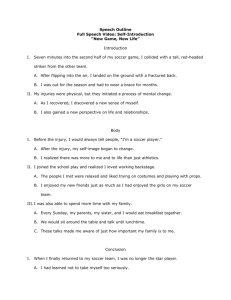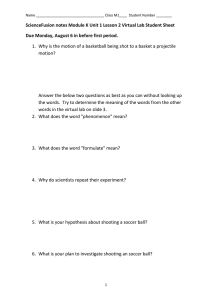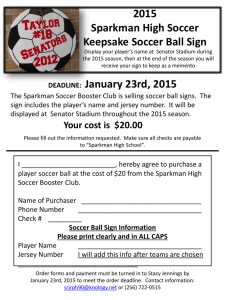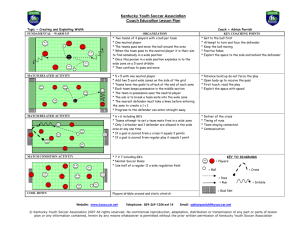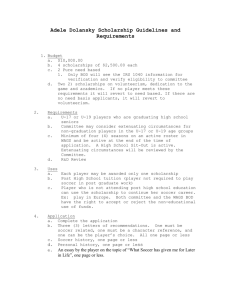Document 13779492
advertisement
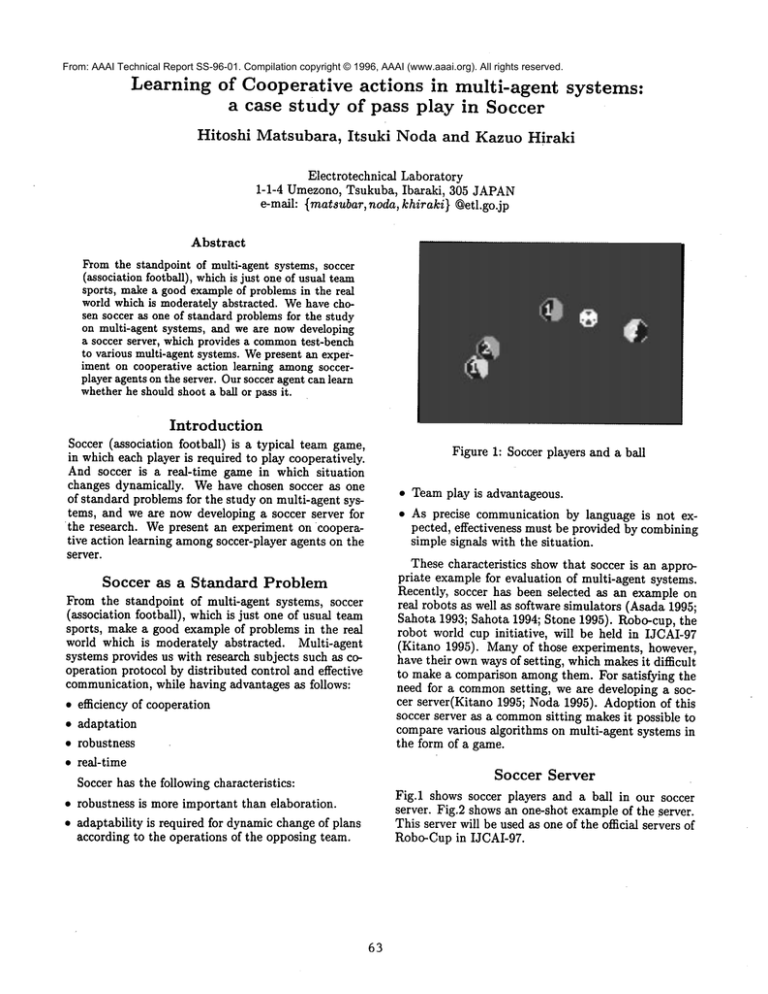
From: AAAI Technical Report SS-96-01. Compilation copyright © 1996, AAAI (www.aaai.org). All rights reserved.
Learning
of Cooperative
actions
in multi-agent
a case study of pass play in Soccer
systems:
Hitoshi Matsubara, Itsuki Noda and Kazuo Hiraki
Electrotechnical Laboratory
1-1-4 Umezono, Tsukuba, Ibaraki, 305 JAPAN
e-maih {matsubar, noda, khiraki} @etl.go.jp
Abstract
Fromthe standpoint of multi-agent systems, soccer
(association football), whichis just one of usual team
sports, makea good exampleof problems in the real
world which is moderately abstracted. Wehave chosen soccer as one of standard problems for the study
on multi-agent systems, and we are now developing
a soccer server, which provides a commontest-bench
to various multi-agent systems. Wepresent an experiment on cooperative action learning amongsoccerplayer agents on the server. Oursoccer agent can learn
whetherhe should shoot a ball or pass it.
Introduction
Soccer (association football) is a typical team game,
in which each player is required to play cooperatively.
And soccer is a real-time game in which situation
changes dynamically. Wehave chosen soccer as one
of standard problems for the study on multi-agent systems, and we are now developing a soccer server for
the research. Wepresent an experiment on cooperative action learning amongsoccer-player agents on the
server.
Figure 1: Soccer players and a ball
¯ Team play is advantageous.
¯ As precise communication by language is not expected, effectiveness must be provided by combining
simple signals with the situation.
These characteristics show that soccer is an appropriate example for evaluation of multi-agent systems.
Recently, soccer has been selected as an example on
real robots as well as software simulators (Asada 1995;
Sahota 1993; Sahota 1994; Stone 1995). Robo-cup, the
robot world cup initiative,
will be held in IJCAI-97
(Kitano 1995). Many of those experiments, however,
have their ownways of setting, which makesit difficult
to make a comparison among them. For satisfying the
need for a commonsetting, we are developing a soccer server(Kitano 1995; Noda 1995). Adoption of this
soccer server as a commonsitting makes it possible to
compare various algorithms on multi-agent systems in
the form of a game.
Soccer as a Standard Problem
From the standpoint of multi-agent systems, soccer
(association football), which is just one of usual team
sports, make a good example of problems in the real
world which is moderately abstracted. Multi-agent
systems provides us with research subjects such as cooperation protocol by distributed control and effective
communication, while having advantages as follows:
¯ efficiency of cooperation
¯ adaptation
¯ robustness
¯ real-time
Soccer Server
Soccer has the following characteristics:
Fig.1 shows soccer players and a ball in our soccer
server. Fig.2 shows an one-shot example of the server.
This server will be used as one of the official servers of
Robo-Cup in IJCAI-97.
¯ robustness is more important than elaboration.
¯ adaptability is required for dynamic change of plans
according to the operations of the opposing team.
63
Figure 2: WindowImage of Soccer Server
Overview
The soccer server provides a virtual field where players
of two teams play soccer. Each player is controlled
by a client program via local area networks. Control
protocols are simple in that it is easy to write client
programs using any kind of programming system that
supports UDP/IP sockets.
¯ Control via Networks
A client can control a player via local area networks.
The protocol of the communication between clients
and the server is UDP/IP. Whena client opens a
UDPsocket, the server assigns a player to a soccer
field for the client. The client can control the player
via the socket.
¯ Physical Simulation
The soccer server has a physical simulator, which
simulates movementof objects (ball and players) and
collisions between them. The simulation is simplified
so that it is easy to calculate the changes in realtime, but the essence of soccer is not lost.
The simulator works independently of communications with clients. Therefore, clients should assume
that situations on the field change dynamically.
¯ Referee
The server has a referee module, which controls each
game according to a number of rules. In the current implementation, the rules are: (1) Check goals;
(2) Check whether the ball is out of play; (3)
trol positions of players for kick-offs, throw-ins and
corner-kicks, so that players on the defending team
keep a minimumdistance from the ball.
Judgmentsby the referee are announcedto all clients
as an auditory message.
Protocol
As described above, a client connects to the server by
a UDP/IP socket. Using the socket, the client sends
commandsto control its player and receives sensory
information of the fields. Commandand sensor information consist of ASCIIstrings.
¯ Initialization
First of all, a client opens a UDPsocket and connects to a server host.(The server’s port number is
assumed to be 6000.) Then, a client sends the following string to the server:
(init
TEAMNAME(POS-X POS-Y)
The server assigns a player whose team name is
"TEAMNAME,
and initializes
its position at (POSX, POS-Y). If the initialization succeeds, the server
returns a following string to the client:
Coach
Mode
In order to make it easy to set up a certain situation,
the server has a coach mode. In this mode, a special
client called ’coach’ can connect to the server, whocan
moveany players and the ball. This mode is useful for
learning client programs.
(init SIDE NUMBER TIME),
where SIDE, NUMBER,TIME indicates the side of
the team (T or ’r’), the player’s uniform number,
and the current time respectively.
Current
Status
The server is implemented by g++ and X window with
Athena widgets.
¯ Action Command
Each client can control its player by 3 kinds of commands, ’turn’, ’dash’ and ’kick’. Clients also can
communicatewith other clients using the ’say’ command. Commandformats axe as follows:
(turn
PO WER)
(dash
POWER)
(kick POWER
DIRECTION)
(say
MESSAG E)
WWW home
page
Programs of the soccer server are available by FTP:
ftp ://ci.etl.go,jp/pub/soccer/server/
sserver-l.
8. tar.gz
Homepage of the soccer server is:
http://ci.etl.go,jp/~noda/soccer/
server,html
We alsohavea mailinglistaboutRobo-Cup:
rjl%csl,
sony.co.jp
Changethe direction of the player
according to POWER. POWER
should be -180 ,,~ 180.
Increase the velocity of the player
toward its direction according
to POWER. POWERshould be
-30 ,-~ 100.
Kick a ball to DIRECTIONaccording
to POWER. POWER
should be -180 ,,~ 180, and DIRECTIONshould be 0 ,-- 100.
This commandis effective only
when the distance between the
player and the ball is less than 2.
Broadcast MESSAGEto all players. MESSAGEis informed immediately to clients using (hear
...) format described below.
These commandsmay not cause expected effects because of physical situation (ex. collisions) and noise.
¯ Sensory Information
Players can see objects in their views. The direction of view of a player is the direction of movement
of the player, and the angle of view is 60 degrees.
Players also can hear messages from other players
and the referee. This information is sent to clients
in the following format:
(see TIME
OBJINFO
OBJINFO... )
(hear TIME
SENDER
MESSAGE)
Inform visual information.
OBJINFOis information about
a visible object, whoseformat is (OBJ-NAME DISTANCE DIRECTION).
This messageis sent 2 times
per second. (The frequency
maybe changed.)
Inform auditory information. This messageis sent
immediately when a client
SENDERsends (say MESSAGE) command. TIME
indicates the current time.
Learning
of pass play
On this soccer server, we are conducting an experiment
on cooperative-action learning amongsoccer players.
Our first aim is to make the players learn howto kick
a pass, which is supposed to be the fundamentals of cooperative action in soccer. The information that Shooting the ball for the enemy’sgoal is the purpose of the
game is already knownto the player agents. It is easy
for a successful shooting which leads to the team score
when there are no enemy players in the area between
him and the goal, that is, whenhe is a free player trying to shoot a goal.
Whenthere are two players from his side and one
player from the other, and the player of the enemy’s
team is defending against him, it is a wiser policy to
pass the ball to a free player of his team than to make
a shoot by himself. Evaluation of action is based on
the score and the time taken for making the score.
Wecarried out an experiment on our server as follows:
¯ There are two offense players and one defense player
in a penalty area.
¯ One offense player A is set at random. A ball is at
his feet in the first place. He will shoot the ball to
the goal or pass it to his teammate. He cannot move
anywhere.
¯ Another offense player B and one defense player C
are set at random. C keeps his position between the
ball and the goal. In some situations (see Fig.3)
marks A (to pass the ball to B is a good strategy
for A). In other situations (see Fig.4) C marks B
shoot the ball to the goal directly is a goodstrategy).
¯ B is programmedto wait the pass from A and shoot
the ball.
65
¯ B: angle is 54 degrees on the left
distance is 4.5
¯ C: angle changes from 30 degrees on the left to 30
degrees on the right
distance is 5.5
Intuitively speaking, it is better to shoot the ball
directly when C is on the left. It is better to pass the
ball when C is between A and the goal. And either
shoot or pass is OKwhen C is on the right.
Fig.6 shows the rates of successes and failures of
shoot and pass before and after learning. Wecan see
that the success rate of shoot is improved. After learning, A does not makefruitless shoots. The success rate
of pass is not so improved. If success rate of B’s shoot
was higher, success rate of A’s pass would be improved
by learning.
Figure 3: Situation where pass is better
Concluding
remarks
In this article, we reported our soccer server and an
experiment of pass-play learning on the server. The
result showsthat our server is useful for researches of
this kind and that our soccer agent can learn his strategy. Weare making further experiments now. For example, we are trying ID-3 as a learning methodinstead
of back propagation.
References
M. Asada, S. Noda, S. Tawaratsumida and K. Hosoda:
Vision-based reinforcement learning for purposive behavior acquisition,
Proc. of IEEE Int. Conf. on
Robotics and Automation (1995)
H. Kitano, M. Asada, Y. Kuniyoshi, I. Noda and
E. Osawa: RoboCup: The robot world cup initiative, IJCAI-95 Working Notes of Entertainment and
AI/Alife Workshop (1995)
I.Noda: Soccer server: a simulator of RoboCup, AI
symposium’95, Japanese Society for Artificial Intelligence (1995)
M.K. Sahota: Real-time intelligent
behavior in dynamic environments: soccer-playing
robot, Master
Thesis, The University of British Columbia, Canada
(1993)
M.K. Sahota: Reactive deliberation: an architecture
for real-time intelligent control in dynamic environments, Proc. of AAAI-94, pp.1303-1308 (1994)
P. Stone and M. Veloso: Learning to pass or shoot:
collaborate or do it yourself, unpublished manuscript
(1995)
Figure 4: Situation where shoot is better
¯ Before learning, A either shoots the ball or passes it
at random. A coach tells nice to A when the offense
players get a goal, and tells fail whenthe ball is out
of field or time is over.
¯ A learns his strategy by back propagation in a neural network. The neural network consists of 8 inputunits, 30 hidden-units and 2 output-units. The network receives relative positions of B, C, the goal and
the ball. And it outputs two values (Opaa,, O,hoot),
which indicate expected success rate of pass and
shoot.
¯ A chooses pass or shoot according to the rate of
Opa,8 and O,^oo~: the probability of choosing pass
is Op~,/(Opa,,+ O,hoo~).
Fig.5 shows changes of outputs of the neural networks for direction to the opponent player C. The situation (from the viewpoint of A) is as follows:
¯ The goal: angle is 16 degrees on the left
distance is 14.0
66
Direction to Goal
Direction lo Tqammate
0.9
\
0.8
0.7
0.6
0.5
o
0.4
0.3
0.2
t
o II
0.1
|
0
-60
I
I
-50
-40
I
I
II
, ÷ pass.out
’
+~-~* "shoot.out"
~’"
I
I
|
-30
-20
-10
0
Directionto OpponentPlayer
I
I
l0
20
Figure 5: Change of output for direction to opponent player.
[learningdata]
nice
fail
total
pass
341(24.6~)
1045(75.4~)
1386
shoot
527(36.1Z)
931(63.9~)
1458
total
868(30.5X)
1976(69.5X)
2844
pass
435(29.9X)
1020(70.1X)
1455
shoot
665(44.1~)
844(55.9~)
1509
total
1100(37.1X)
1864(62.9~)
2964
pass
506(31.4X)
1105(68.6X)
1611
shoot
708(52.1X)
651(47.9X)
1359
total
1214(40.9~)
1756(59.1X)
2970
[beforelearning]
nice
fail
total
[after
learning]
nice
fail
~otal
Figure 6: Success rate before and after learning
67
30



